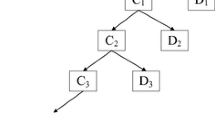Abstract
In this paper we firstly analysis the chaotic characters of three sets of the financial time series (Hang Sheng Index (HIS), Shanghai Stock Index and US gold price) based on the phase space reconstruction. But when we adopt the feedforward neural networks to predict those time series, we found this method run short of a criterion in selecting the training set, so we present a new method: using correlation dimension (CD) as the criterion. By the experiments, the method is proved effective.
Preview
Unable to display preview. Download preview PDF.
Similar content being viewed by others
References
Kim, S.H., Hyun, J.N.: Predictability of Interest Rates Using Data Mining Tools: A Comparative Analysis of Korea and the US. Expert Systems with Application 13, 85–95 (1997)
Cecen, A.A., Erkal, C.: Distinguishing between stochastic and deterministic behavior in high frequency foreign exchange rate returns: Can non-linear dynamics help forecasting? International Journal of Forecasting 12, 465–473 (1996)
Harrison, R.G., Yu, D., Oxley, L., Lu, W., George, D.: Non-linear noise reduction and detecting chaos: some evidence from the S&P Composite Price Index. Mathematics and Computers in Simulation 48, 407–502 (1999)
Catherine, K., Walter, C.L., Michel, T.: Noisy chaotic dynamics in commodity markets. Empirical Economics 29, 489–502 (2004)
Rosenstein, M.T., Collins, J.J., De luca, C.J.: Apractial method for calculating largestLyapunov exponents in dynamical systems. Physica D 65, 117–134 (1993)
Lu, J.H., Zhang, S.C.: Application of adding-weight one-rank local-region method in electric power system short-term load forecast. Control Theory And Application 19, 767–770 (2002)
Oh, K.J., Han, I.: Using change-point detection to support artificial neural networks for interest rates forecasting. Expert Systems with Application 19, 105–115 (2000)
Leung, M.T., Chen, A., Daouk, H.: Forecasting exchange rates using general regression neural networks. Computer and Operations Research 27, 1093–1110 (2000)
Kermanshahi, B.: Recurrent neural network for forecasting next 10 years loads of nine Japanese utilities. Neurocomputing 23, 125–133 (1998)
Holger, K., Thomas, S.: Nonlinear Time Series Analysis. Qinghua University Press, Beijing (2000)
de Oliveira, K., Andrésia, V., da Silva, Á., Elton, C.: Using artificial neural networks to forecast chaotic time series. Physica A 284, 393–404 (2000)
Kennel, M.B., Abarbanel, H.D.: Determining embedding dimension for phase space reconstruction using a geometric construction. Physical Review A 151, 225–233 (1990)
Buczkowski, S., Hildgen, P., Cartilier, L.: Measurements of fractal dimension by boxcounting: a critical analysis of data scatter. Physica A 252, 23–34 (1998)
Heinz, O.P., Dietmar, S.E.: The science of fractal Image, pp. 71–94. Springer, Heidelberg (1988)
Wang, H.Y., Zhu, M.: A prediction comparison between univariate and multivariate chaotic time series. Journal of Southeast University (English Edition) 19, 414–417 (2003)
Zhang, J., Lam, K.C., Yan, W.J., Gao, H., Li, Y.: Time series prediction using Lyapunov exponents in embedding phase space. Computers and Electrical Engineering 30, 1–15 (2004)
Grassberger, P., Procaccia, I.: Measuring the strangeness of the strange attractors. Physica 9D, 189–208 (1983)
Author information
Authors and Affiliations
Editor information
Editors and Affiliations
Rights and permissions
Copyright information
© 2005 Springer-Verlag Berlin Heidelberg
About this paper
Cite this paper
Feng, C., Ji, G., Zhao, W., Nian, R. (2005). The Prediction of the Financial Time Series Based on Correlation Dimension. In: Wang, L., Chen, K., Ong, Y.S. (eds) Advances in Natural Computation. ICNC 2005. Lecture Notes in Computer Science, vol 3610. Springer, Berlin, Heidelberg. https://doi.org/10.1007/11539087_165
Download citation
DOI: https://doi.org/10.1007/11539087_165
Publisher Name: Springer, Berlin, Heidelberg
Print ISBN: 978-3-540-28323-2
Online ISBN: 978-3-540-31853-8
eBook Packages: Computer ScienceComputer Science (R0)




